Welcome to the rich and complex world of Japanese tea. If you think "green tea" is a single flavor, you're in for a delightful surprise. From the vibrant, powdered Matcha of ancient ceremonies to Sencha, the daily green tea beloved across Japan, each variety tells a unique story shaped by centuries of tradition.
Your Journey Into Japanese Tea Begins Here
Getting into Japanese tea is a lot like exploring a famous wine region. While everything comes from the same plant, Camellia sinensis, the final results are wonderfully diverse. The real magic is in Japan's unique cultivation and processing methods, especially their masterful use of shading and steaming. These two techniques are what create the incredible spectrum of flavors, aromas, and colors.
Think of shading as giving the tea plants a bit of a break from the sun. Weeks before harvest, farmers cover the bushes, which encourages them to produce more chlorophyll and L-theanine. This doesn't just make the leaves a deeper, more beautiful green; it also builds that coveted umami flavor—a savory, brothy richness that is the hallmark of premium teas like Gyokuro and Matcha.
Steaming, on the other hand, is all about timing. Almost immediately after picking, the fresh leaves are steamed to stop oxidation in its tracks. This crucial step is what locks in their vibrant green hue and fresh, vegetal character. It's a world away from the oxidized black teas you might be more familiar with.
The growing global appreciation for these teas is really a testament to their unique qualities. It shows how these ancient methods produce something that's not just delicious, but deeply connected to a culture of wellness and mindfulness.
Before we dive into each specific tea, let's get a quick snapshot of the main players. This table will help you keep the key differences straight as we go.
Quick Overview of Major Japanese Tea Types
| Tea Type | Processing Style | Flavor Profile | Color |
|---|---|---|---|
| Matcha | Shade-grown, steamed, dried, and stone-ground into a fine powder. | Rich, creamy, intense umami, with a slightly sweet finish. | Vibrant, electric green. |
| Gyokuro | Shade-grown for ~3 weeks, steamed, and rolled into fine needles. | Deeply savory (umami), sweet, with a distinct seaweed-like aroma. | Deep, emerald green. |
| Sencha | Sun-grown, steamed, and rolled. The most popular tea in Japan. | Fresh, grassy, slightly astringent with a sweet aftertaste. | Bright, yellowish-green. |
| Hojicha | Roasted Sencha or Bancha leaves and stems over charcoal. | Nutty, toasty, and smoky with low caffeine. | Reddish-brown. |
| Genmaicha | Sencha or Bancha mixed with roasted, popped brown rice. | Savory and nutty from the rice, with a grassy green tea base. | Pale, yellowish-brown. |
| Bancha | Harvested later in the season from coarser, larger leaves. | Earthy, robust, and more astringent than Sencha. | Yellowish-green. |
This overview gives you a solid starting point. Now, you're ready to explore what makes each of these teas special.
A World of Tea Awaits
With this foundation, you can start to appreciate the subtle (and not-so-subtle) differences between the major types of Japanese tea. This guide is your map to this fascinating landscape, covering everything from everyday favorites to ceremonial-grade treasures. You'll soon be able to distinguish between:
- Vibrant Powdered Teas: Like Matcha, where you're actually drinking the entire ground leaf.
- Delicate Leaf Teas: Such as Sencha and the exquisite, shade-grown Gyokuro.
- Roasted and Blended Teas: Including the toasty Hojicha and savory Genmaicha.
The global interest in these teas isn't just about the taste; it's also about well-being. The Japanese tea market is projected to grow at a CAGR of 8.9% from 2022 to 2032, largely driven by a wider recognition of its health benefits, like high antioxidant levels. For more on this trend, you can read about the growing Japanese tea market and its drivers.
The Secrets of Shading and Steaming
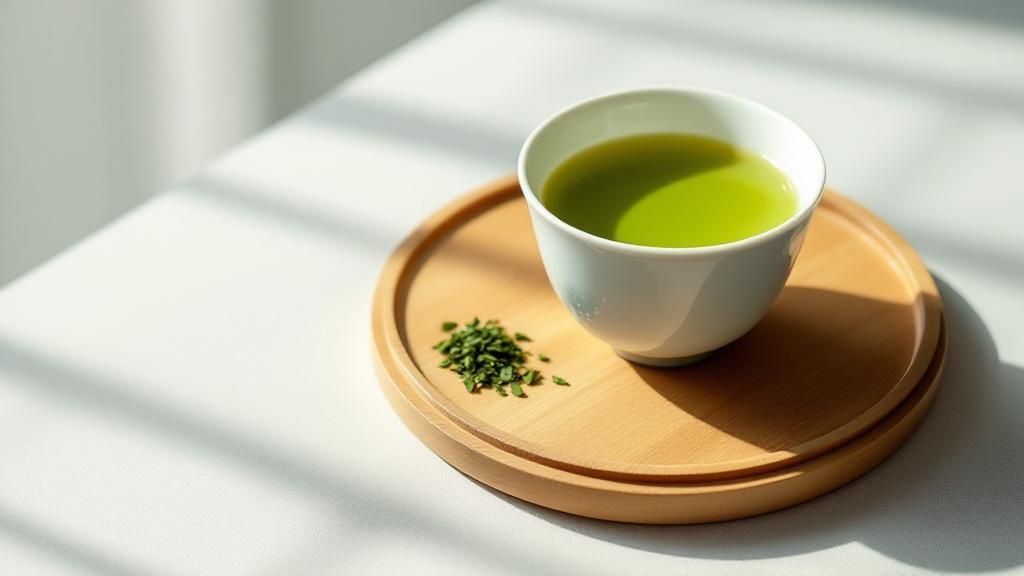
If you really want to get to the heart of what makes different Japanese tea types unique, it all comes down to two specific techniques: shading and steaming. These aren't just minor steps in a long process. They are the defining moments that shape the flavor, color, and soul of almost every green tea that comes out of Japan.
Think of it like tending to a prized plant in your garden. To get the most vibrant bloom, you might shield it from the harsh afternoon sun. Tea farmers do something very similar. For high-end teas like Gyokuro and Matcha, the bushes are carefully covered with special tarps for about 20 to 30 days before harvest.
This simple act of blocking sunlight triggers a fascinating change in the tea plant. It forces the leaves to produce more chlorophyll, which is why they develop such a stunning, deep green color. But here’s the real magic: this process stops an amino acid called L-theanine from turning into catechins—the compounds that cause bitterness. The result? A tea that is incredibly sweet, savory, and full of that sought-after umami depth.
The Power of Shading
Shading isn't just about protection; it's a deliberate method for cultivating flavor. This is what gives certain Japanese teas their luxurious, silky character and a taste that is both complex and deeply satisfying.
- Creates Rich Umami: That high L-theanine content is precisely where the savory, brothy flavor of teas like Gyokuro comes from.
- Softens the Flavor: By keeping bitter catechins low, shading results in a remarkably smooth, sweet cup with virtually no harsh edge.
- Deepens the Color: The extra chlorophyll gives the brewed tea that brilliant emerald-green hue that connoisseurs look for.
The Critical Role of Steaming
The moment the precious leaves are plucked, the race against time begins. This is where Japan's second signature technique, steaming, takes center stage. While Chinese green teas are often pan-fired to stop oxidation, Japanese teas are steamed almost immediately—sometimes within just a few hours of being picked.
This quick blast of steam, known in Japanese as mushi, instantly halts the enzymes that would otherwise cause the leaves to oxidize and turn brown. It’s this rapid intervention that locks in that fresh, vegetal character and bright green color. It essentially freezes the leaf in time, preserving its "just-picked" essence and preventing the development of the toasted or earthy notes you might find elsewhere.
By stopping oxidation in its tracks, steaming acts like a flavor time capsule. It perfectly captures the vibrant, grassy notes of the fresh tea leaf, giving teas like Sencha their signature profile.
Even the length of the steam matters. A longer steam (fukamushi), for instance, breaks down the leaf’s cell walls more, yielding a darker green liquor and a bolder, sweeter brew. Of course, getting the brew right is everything. That’s why following specific brewing advice can make a world of difference, especially for a classic steamed tea. You can find some great pointers in our complete Sencha brewing instructions.
Ultimately, shading and steaming are the one-two punch that gives Japanese green tea its unmistakable identity.
Understanding Matcha: The Heart of Tea Culture
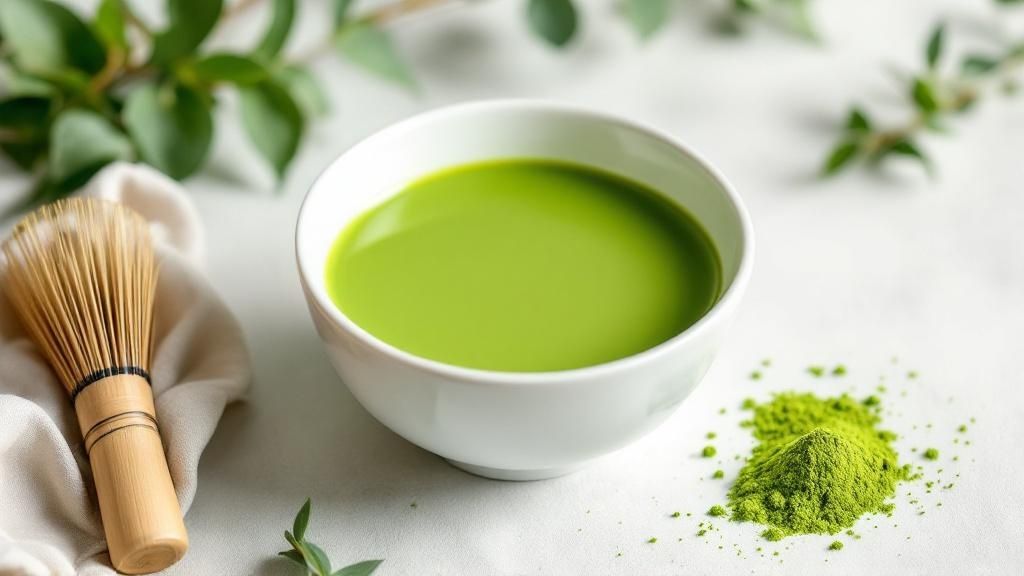
When we talk about Japanese tea, Matcha truly stands in a class of its own. It’s far more than just a beverage; it’s a cultural icon, a meditative practice, and the very soul of the traditional Japanese tea ceremony, known as Chadō (The Way of Tea).
With most teas, you steep the leaves in water and then discard them. But with Matcha, you're doing something fundamentally different. You consume the entire leaf, which has been ground into a vibrant, microscopic powder.
This unique approach means you get 100% of the leaf's nutrients, including its powerful antioxidants and amino acids. The journey begins with tencha, the same shade-grown leaves used for high-end Gyokuro. After being steamed and dried, these leaves are painstakingly de-veined and de-stemmed. Finally, they are stone-ground into an impossibly fine powder—a process so meticulous it can take an hour to produce just 30 grams of premium Matcha.
Ceremonial vs. Culinary Grade
To really appreciate Matcha, it’s crucial to understand the difference between its grades. This isn’t about "good" versus "bad," but rather about choosing the right tool for the job. Think of it like cooking with wine versus sipping a fine vintage; you wouldn't pour your best bottle into a stew.
-
Ceremonial Grade: This is the best of the best, made from the youngest, most tender leaves of the first harvest. It boasts a brilliant green color, a silky texture, and a complex, umami-rich flavor with almost no bitterness. This is the grade reserved for the traditional tea ceremony, whisked with nothing but hot water.
-
Culinary Grade: Sourced from later harvests, this grade has a more robust, slightly bitter flavor profile that’s designed to shine through other ingredients. It's the perfect choice for lattes, smoothies, baking, and cooking. Its color is still green, just a bit less vibrant than its ceremonial sibling.
The core principle of Matcha is mindfulness. The ritual of preparing a bowl—sifting the powder, adding water, whisking it into a froth—encourages focus and a deep appreciation for the present moment. This is what keeps it so central to Japanese culture.
The global fascination with Matcha is impossible to ignore, and its popularity just keeps growing. In Japan alone, the Matcha tea market hit USD 391.1 million in 2024 and is on track to approach USD 600 million by 2030. While the traditional powder form remains king, instant premixes are quickly carving out their own space in the market.
How to Whisk a Perfect Bowl of Matcha
Making Matcha at home is a simple, rewarding ritual. With the right tools and a little practice, you can create a smooth, frothy bowl that honors its rich tradition.
-
Gather Your Tools: You’ll want a Matcha bowl (chawan), a bamboo whisk (chasen), and a bamboo scoop (chashaku).
-
Sift the Matcha: Use a small sifter to add 1-2 scoops (about 2 grams) of ceremonial grade Matcha to your bowl. Sifting is the secret to preventing clumps and getting that perfectly smooth texture.
-
Add Hot Water: Pour in about 2-3 ounces (60-90ml) of hot—but not boiling—water. The sweet spot is around 175°F (80°C). Water that’s too hot will scorch the tea, making it taste bitter.
-
Whisk Vigorously: Hold the bowl firmly with one hand. With the other, whisk rapidly by tracing a "W" or "M" pattern. Keep your wrist loose and try not to scrape the whisk against the bottom of the bowl.
-
Create the Froth: After 15-20 seconds of whisking, a beautiful layer of fine, creamy foam will appear. When the froth looks stable, gently lift the whisk from the center of the bowl.
The finished tea should be a brilliant green, with a rich, vegetal aroma and a deep umami flavor that is both energizing and calming. Its distinctive taste has also inspired other unique products, like this Matcha Green Tea candle.
If you're curious about its wellness aspects, there are plenty of proven advantages to making Matcha a regular habit. To learn more, check out our guide on the 8 benefits of drinking matcha you should know.
Sencha and Gyokuro: The Art of Leaf Tea
While Matcha may be the star of the formal tea ceremony, the world of steeped leaf tea is where most Japanese people find their daily dose of comfort. In this world, two giants stand out from all other Japanese tea types: Sencha and Gyokuro. They both start from the same plant, but their journeys from field to cup create two profoundly different experiences.
Sencha is, without a doubt, the people's champion of Japanese tea. It makes up nearly 80% of all tea produced in the country and is the vibrant, refreshing green tea you’ll find on tables in homes and restaurants all across Japan. Unlike its shaded cousins, Sencha is a sun-worshipper. The bushes are grown in full, direct sunlight, which pushes the plant to create more catechins, the compounds responsible for that pleasant, brisk quality.
This sun-drenched upbringing gives Sencha its signature flavor: a beautiful balance of fresh, grassy notes, a light astringency, and a subtly sweet finish. It’s the perfect everyday tea—clean, invigorating, and wonderfully drinkable.
The Bright Character of Sencha
The appeal of Sencha lies in its honest, straightforward character. It doesn't have the deep, brothy umami of a shaded tea, but instead offers a crispness that is uniquely satisfying. A good cup of Sencha truly captures the essence of a fresh spring meadow in a cup.
But brewing it correctly is key. If your water is too hot, you'll scorch the leaves and release too many tannins, making the tea bitter and harsh. To get it just right and highlight its bright, sweet notes, aim for a water temperature around 160-175°F (70-80°C) and steep it for just about one minute.
Gyokuro: The Shade-Grown Jewel
If Sencha is the dependable, sun-kissed friend, Gyokuro is its rare and sophisticated counterpart. The name Gyokuro even translates to "jade dew," a nod to the stunning, deep green color of the brewed tea. This is the pinnacle of Japanese leaf tea, celebrated for its extraordinary flavor and aroma.
The secret to Gyokuro's magic is the shading process. For about three weeks before the leaves are harvested, the tea plants are carefully covered with reed mats or cloth, blocking out roughly 90% of the sunlight. This period of near-darkness completely changes the leaf's chemistry.
By shielding the leaves from the sun, farmers stop the amino acid L-theanine from turning into bitter catechins. This dramatically boosts the L-theanine levels, flooding the leaves with that profound, savory sweetness we call umami.
This painstaking method results in a tea that is worlds away from Sencha. Gyokuro has a thick, almost syrupy texture, an intense umami richness, and a sweet, lingering finish that coats your entire mouth. Its unique aroma, often described as smelling like fresh seaweed, is known as ooika.
Mastering the Art of Brewing Gyokuro
Brewing Gyokuro is a delicate art that demands both patience and precision. Its fragile, umami-packed leaves are easily ruined by hot water. To coax out its complex, sweet flavors, you have to use much cooler water than you would for any other tea. Of course, starting with a high-quality product is a must, and our guide on the top 10 best Japanese tea brands for 2025 can point you toward an excellent Gyokuro.
Here’s a simple guide to brewing this exquisite tea:
- Use Very Cool Water: This is the most important step. The ideal water temperature for Gyokuro is between 122-140°F (50-60°C). This cool water gently unlocks its sweet umami without pulling out any bitterness.
- Measure Your Leaves: Be generous. Use about two heaping teaspoons for a small Japanese teapot (kyusu).
- Steep Slowly: Pour the cool water over the leaves and let them steep for longer than you might think—typically 90 seconds to two minutes.
- Pour Out Every Last Drop: The final drops are the richest and most concentrated. Make sure you empty the pot completely, which also sets the leaves up perfectly for a second brew.
A well-prepared cup of Gyokuro is a truly special moment. It's a meditative, savory, and sweet tea that showcases the incredible artistry behind Japan’s finest teas.
Getting to Know Hojicha, Bancha, and Genmaicha
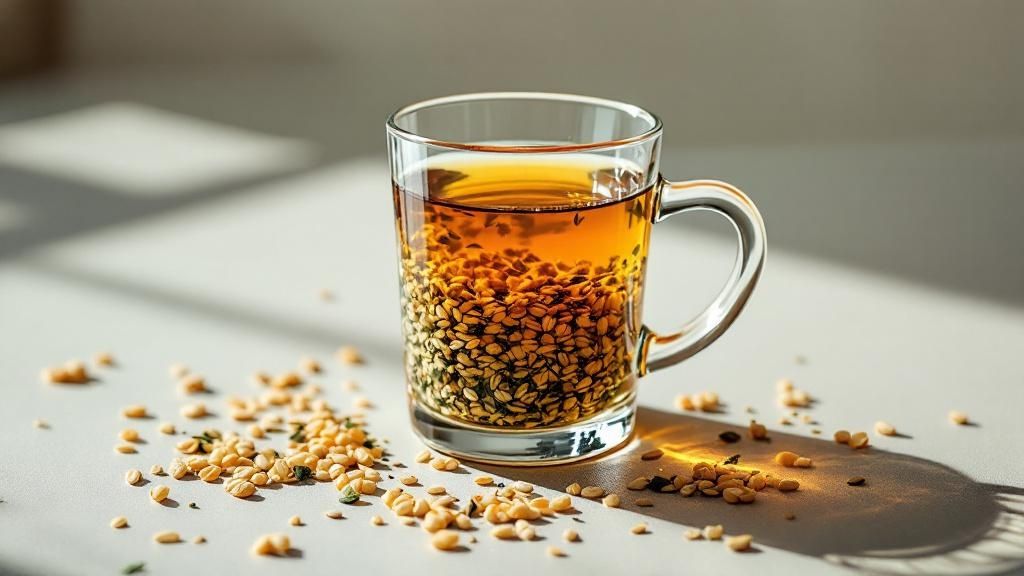
Once you venture past the delicate, grassy world of premium steamed greens, you'll discover another, cozier side of Japanese tea types. This is where you find the everyday staples—the wonderfully approachable and comforting teas like Bancha, Hojicha, and Genmaicha that bring a different kind of warmth to the table.
Our journey starts with Bancha (番茶), which often gets translated as "common" or "coarse" tea. Honestly, that description doesn't do it justice. Bancha is typically made from the larger, tougher leaves and stems that are picked later in the season, well after the prime harvest for Sencha is over.
Because these mature leaves have spent more time soaking up the sun, they naturally have less caffeine and more catechins. This gives Bancha a much more robust, earthy, and slightly astringent flavor compared to its grassy cousins. It's a hearty, no-fuss tea that's perfect for sipping any time of day.
Hojicha: The Comfort of Roasting
From the humble Bancha leaf comes one of Japan’s most comforting creations: Hojicha (ほうじ茶). Hojicha isn't grown differently; it's processed differently. Tea makers take Bancha (or sometimes Sencha) leaves and stems and roast them over high heat, traditionally using charcoal.
This simple step completely transforms the tea. The intense heat breaks down most of the caffeine and tannins, leaving you with a brew that's exceptionally low in caffeine and has practically zero bitterness.
What you get instead is a deeply satisfying, toasty aroma and a nutty, almost caramel-like flavor. Its reddish-brown color is as warm and inviting as its taste, and it's famously gentle on the stomach. This makes Hojicha a go-to choice for the evening, for kids, or for anyone sensitive to caffeine. It's truly the tea equivalent of wrapping yourself in a warm, cozy blanket.
Hojicha is a brilliant example of Japanese resourcefulness. By roasting later-harvest leaves, tea makers created an entirely new and delicious tea that minimizes waste and offers a completely different sensory experience. It's a testament to finding beauty in simplicity.
This appreciation for diverse tea preparations is part of a much larger wellness movement. The Japanese herbal tea market was estimated at USD 1.24 billion in 2023 and is expected to grow as more people seek out healthy, flavorful drinks.
Genmaicha: The Famous "Popcorn Tea"
Next up is one of the most distinctive and globally recognized Japanese teas: Genmaicha (玄米茶). You might know it by its fun nickname, "popcorn tea." This unique blend combines green tea—usually Bancha or Sencha—with roasted brown rice, or genmai. Some of the rice grains even pop during roasting, which is where the nickname comes from!
The origin of Genmaicha is rooted in practicality. It was once called the "people's tea" because the rice was used as a filler, stretching the tea leaves and making it more affordable. Today, of course, it’s cherished by everyone for its one-of-a-kind flavor.
The roasted rice gives the tea a wonderful nutty, savory quality that perfectly balances the fresh, grassy notes of the green tea. It's a beautiful marriage of flavors—hearty, warming, and with a naturally sweet finish that makes it incredibly easy to drink. If you’re looking for a tea that’s both interesting and deeply satisfying, Genmaicha is a fantastic place to start.
Many of these teas also come with wellness benefits. If that piques your interest, take a look at our guide to Japanese tea for weight loss and our top 7 picks.
For anyone starting their journey with these teas, getting the brew right is key to unlocking their best flavors. Here’s a quick reference guide to help you out.
Brewing Guide for Common Japanese Teas
| Tea Type | Water Temperature (°C/°F) | Steeping Time | Leaf to Water Ratio |
|---|---|---|---|
| Bancha | 80°C / 175°F | 1-2 minutes | 1 tsp per 8 oz / 240ml |
| Hojicha | 90-100°C / 195-212°F | 30-60 seconds | 1 tbsp per 8 oz / 240ml |
| Genmaicha | 80-85°C / 175-185°F | 1-2 minutes | 1 tsp per 8 oz / 240ml |
Remember, these are just starting points. Don't be afraid to experiment with the ratios and steeping times to find what you enjoy most. Happy brewing
How to Choose and Store Japanese Tea
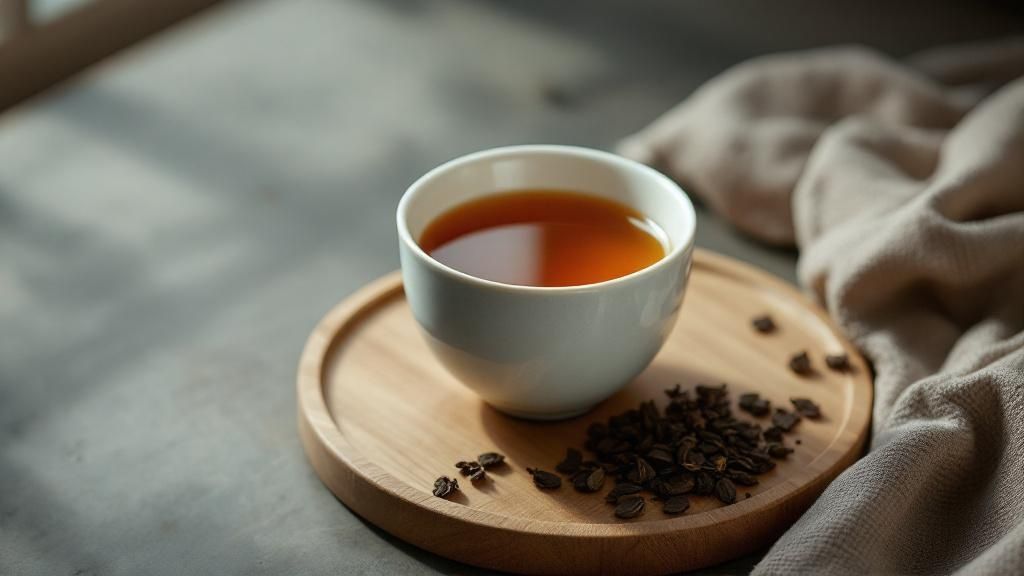
Now that you can tell a Sencha from a Hojicha, you're ready for the next step in your tea journey: bringing a great one home and keeping it that way. Learning to pick a quality tea and store it properly is just as important as knowing how to brew it.
Think of premium tea leaves like you would a delicate fresh herb or a fine loaf of artisan bread. They have a peak freshness that you want to preserve. This is especially true for un-oxidized green teas like Sencha and Gyokuro, whose beautiful, grassy notes are fragile and the first to disappear when exposed to the elements.
Reading the Label: What to Look For
When you're standing in front of a shelf of teas, the packaging itself tells a story. A few key details can help you separate the truly special teas from the rest.
First, look for a harvest date. The most sought-after teas are from the very first harvest of spring, called shincha (新茶), which translates to "new tea." Picked from late April into May, shincha is celebrated for its remarkably low bitterness and sweet, fresh flavor profile, thanks to a high amino acid content. It's a seasonal delight that tea lovers get very excited about each year.
Next, check the origin. Just as certain regions in France are famous for wine, places like Uji (near Kyoto) or the fields of Shizuoka are legendary for their tea. A specific origin is a great sign of a higher-grade tea, much more so than a generic "Product of Japan" label. If you're looking for powdered tea, you can find some fantastic choices by exploring a list of the top 7 best Japanese Matcha brands for 2025.
Protecting Your Tea From Its Four Enemies
Once you've brought that beautiful tea home, your job is to become its guardian. You have to shield it from four key things that will rob it of its flavor and aroma faster than anything else.
Tea is incredibly sensitive. Light, heat, moisture, and strong odors are the nemeses of freshness. Proper storage is not just a suggestion—it's essential for preserving the flavor you paid for.
The best defense is a simple one: an airtight, opaque container. Those clear glass jars might look lovely on the kitchen counter, but they’re a death sentence for delicate tea leaves. Light will literally bleach the flavor and color right out of them.
Here’s how to create the perfect safe haven for your tea:
- Block Out Light: Always, always use a container you can't see through. Traditional Japanese tea canisters, or chazutsu, are designed for exactly this purpose.
- Avoid Heat: Find a cool, dark cupboard away from the stove, oven, or a sunny windowsill. Heat essentially "cooks" the leaves, destroying their complex character.
- Prevent Moisture: An airtight seal is a must. Any moisture that gets in will spoil the tea and can even cause mold to grow.
- Isolate from Odors: Tea leaves are like sponges for smells. Never store your tea next to your coffee beans, spice rack, or garlic.
By following these simple rules, you guarantee that every cup you brew will be as vibrant and delicious as the day the tea was packed. It's a small effort that lets you fully appreciate the wonderful, subtle differences that make each type of Japanese tea a unique experience.
Answering Your Questions About Japanese Tea
Diving into the world of Japanese tea is exciting, but it often brings up a few questions. Once you start noticing the subtle differences between a grassy Sencha and a rich Gyokuro, you naturally get curious. How much caffeine are you drinking? What makes the tea so vibrant? And are you really supposed to add milk?
Let's clear up some of the most common questions. Think of this as a friendly chat to help you understand and enjoy your tea even more.
Does All Japanese Green Tea Have Caffeine?
Yes, because all real tea comes from the Camellia sinensis plant, which naturally contains caffeine. But here's the important part: the amount of caffeine can be wildly different from one tea to the next.
Several things affect the final caffeine level, like when the leaves were picked, whether they grew in the sun or shade, and how they were processed. Shade-grown teas like Matcha and Gyokuro pack the biggest caffeine punch because the shading process actually kicks caffeine production into high gear.
If you're looking for something with less of a kick, you have some fantastic low-caffeine options.
- Hojicha: This is my go-to for an evening cup. It’s roasted over high heat, and that toasting process burns off a good portion of the caffeine, leaving you with a warm, mellow brew.
- Bancha: Made from older, more mature leaves picked later in the season, Bancha naturally has less caffeine than its first-harvest cousins like Sencha.
What Makes Japanese Tea Green?
The brilliant green color you see in most Japanese teas comes down to one crucial step: steaming. Right after the leaves are plucked, they're hit with a blast of hot steam. This immediately stops oxidation—the very same process that makes a sliced apple turn brown.
Think of it like flash-freezing fresh vegetables to lock in their color and nutrients. Steaming does the same for tea leaves, preserving their chlorophyll and all those fresh, green characteristics.
This is the fundamental difference between Japanese green tea and other teas. Black teas are fully oxidized, and oolongs are partially oxidized, which gives them their darker colors and different flavor profiles. Steaming is what keeps Japanese tea so vividly green and full of fresh, vegetal flavor.
Is It Okay to Add Milk or Sugar to Japanese Green Tea?
Honestly, you can drink your tea any way you like! But traditionally, you wouldn't add milk or sugar to high-quality Japanese green teas such as Sencha, Gyokuro, or even a ceremonial-grade Matcha.
The reason is all about flavor. These teas have wonderfully complex and delicate notes—some are grassy, some are sweet, and some have that savory umami depth. Adding milk or a sweetener would completely mask these subtleties. When you brew them carefully with the right water temperature, you unlock their natural sweetness, so there's really no need for sugar. If your green tea tastes bitter, the water was probably too hot.
Of course, there are exceptions. Culinary-grade Matcha is perfect for making lattes, blended with steamed milk and often a touch of sweetener. You might even find a cozy Hojicha latte in some cafes. But if you want to experience the true character of the tea, it's best to enjoy it on its own.
Ready to explore the authentic flavors of Japan? From premium teas to sought-after skincare, Buy Me Japan brings the best of Japan directly to you. Discover our curated collection and enjoy an exceptional shopping experience. Shop now at Buy Me Japan and start your journey today.
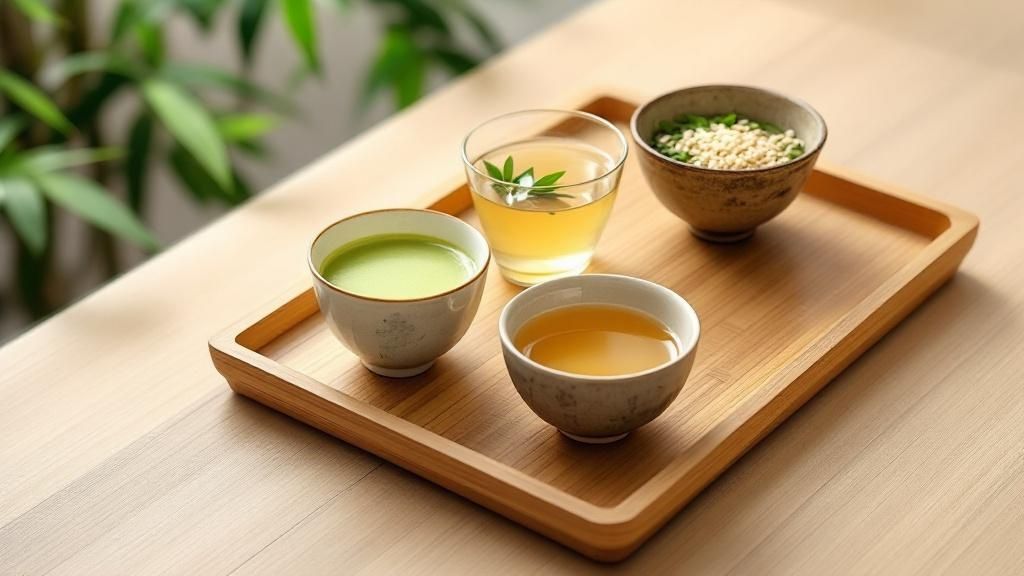
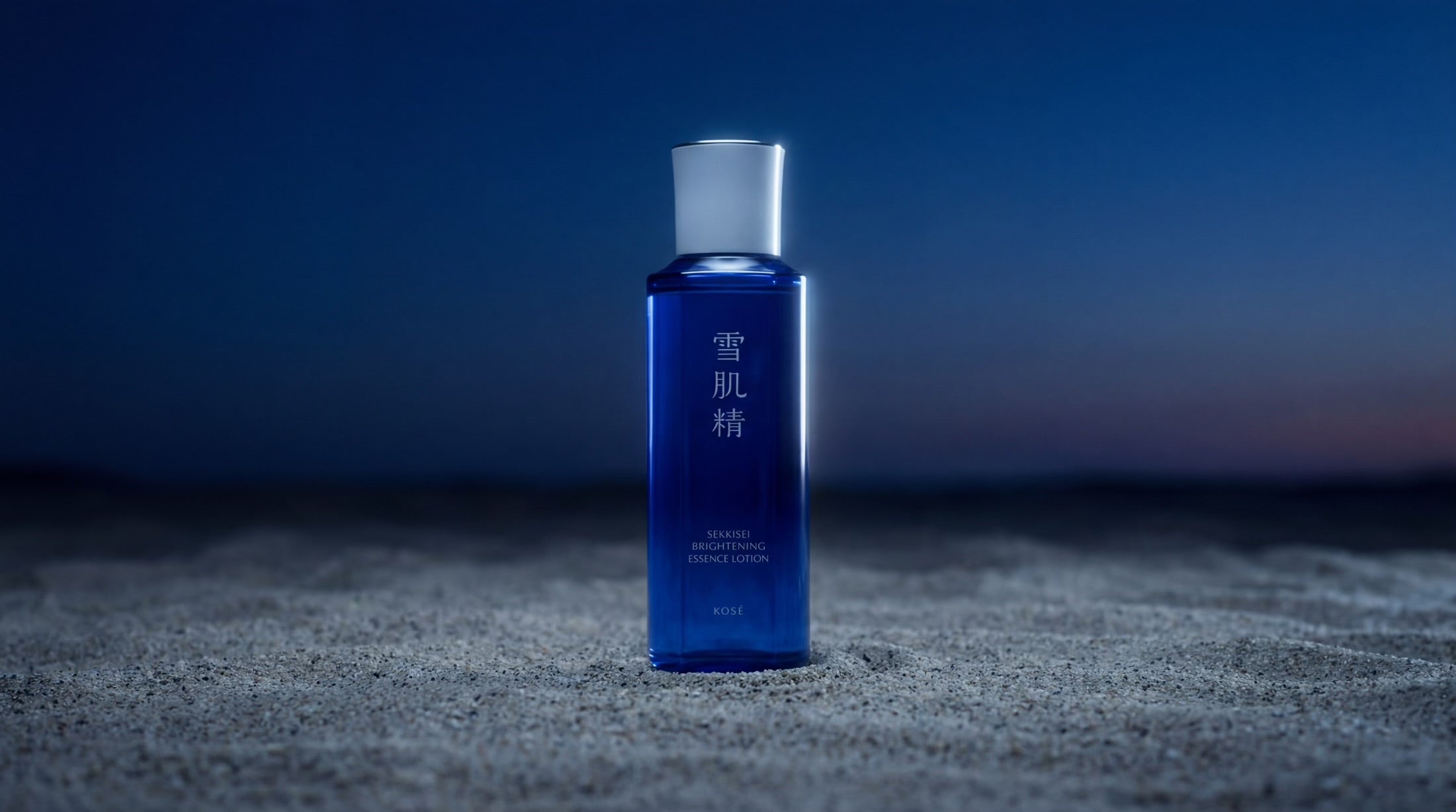
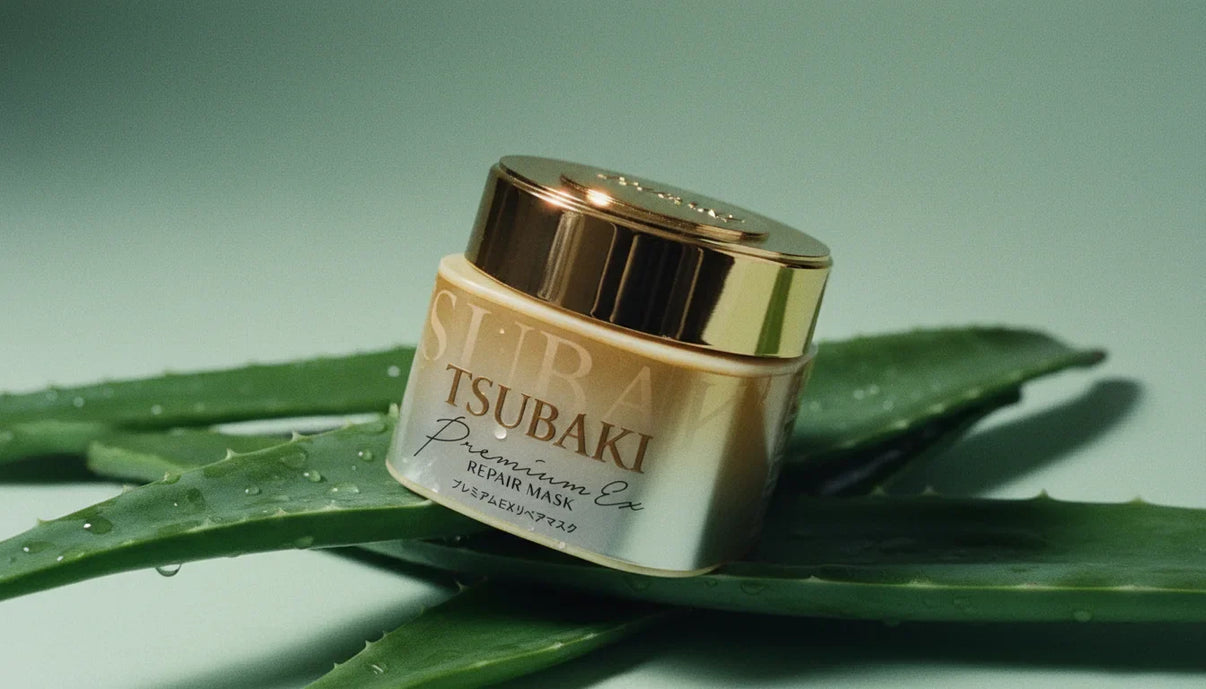
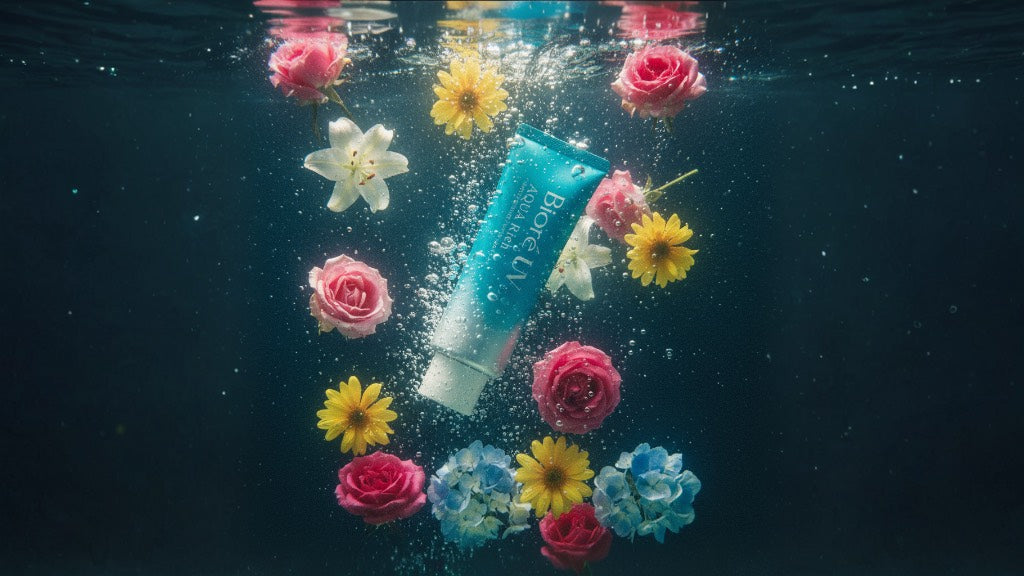
Share:
Top 10 Popular Japanese Beverages You Must Try
12 Best Japanese Tea Brands for the Authentic Sip in 2025